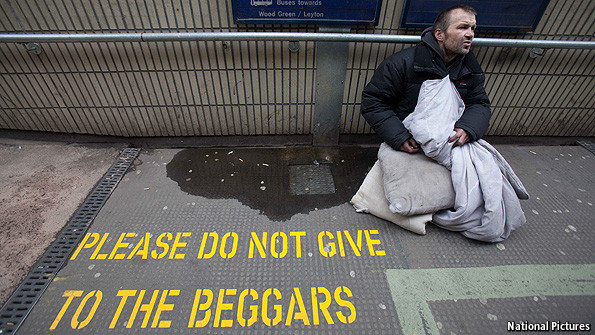美國人口普查局表示,將進一步推遲今年的10年一次人口普查,
Robert Reich
Today is Census Day!
Filling out the 2020 Census determines trillions of dollars of funding, how many Congressional leaders each state has, and Congressional redistricting. After the 2010 Census, Republicans swept into power in state legislatures and governorships and secured a decade of uneven political power.
Filling out the 2020 Census and making sure every single person is counted means we can even the scales and reform our democracy. If we don't, we can expect another decade of Republican minority rule.
So please: fill out your form by mail, call 1-844-330-2020, or respond at mycensus2020.gov.
America's census operation involves hundreds of thousands of workers knocking on doors across the country. That now looks impossible
ECONOMIST.COM
Covid-19 threatens to disrupt America’s 2020 census
How to count people during a pandemic
In 2020 Census, Big Efforts in Some States. In Others, Not So Much.
By MICHAEL WINES and JOSE A. DEL REAL
California is spending $187 million to try to ensure an accurate count of its population. The Texas Legislature decided not to devote any money to the job. Why? The key seems to be which party controls state government.
Hacking, Glitches, Disinformation: Why Experts Are Worried About the 2020 Census
By CHRIS HAMBY
The government plans to deploy new technology for next year’s head count, but risks abound.
一場可能改變美國政治格局的人口普查
美國2020年人口普查即將開啟。因為調查表上的一個變動,這場十年一次的人口普查可能將永久改變美國的政治格局。
|
人口普查在美國極為重要,它將決定重新劃分選區時,每個州在眾議院所佔的席位,以及數千億美元聯邦預算的分配比例。
|
“最高法院的保守派多數派似乎準備允許在2020年的下一次人口普查(census)中,詢問受訪者是否為美國公民。”時報報導指出,在人口普查230年的歷史上,美國人從未被問及過這個問題。
|
census一詞來自拉丁文cēnsus,由表示“給出建議和評估、執行審查的職責”的cēnsēre和表示動作的後綴“tus”組合而成,原意是羅馬早期的人口統計和財產評估,現在通常用於表示官方展開的調查,尤其特指政府對人口的定期統計。
|
For the first time ever, the U.S. plans to officially collect census responses in Arabic, French, Haitian Creole, Japanese, Polish, Portuguese and Tagalog.
More Stories From NPR
NATIONAL
The Census Bureau Needs To Hire Half A Million Workers For The 2020 Count
蘇先生有轉此篇 How do you count the homeless?
http://yifertw.blogspot.tw/2013/08/homeless.html
我在那兒有些簡單的解釋和說明 它也牽涉到"可運作的定義"問題以及台北龍山寺的街友之詳細影片紀錄等等
日本的街友可能更多點了: Old age far from gentle for Japan's graying homele...
How do you count the homeless?
by G.J.
It partly depends on the definition of homelessness. Britain has two categories: "rough sleeper", meaning someone who sleeps on the streets; and "statutory homelessness" for people who are in temporary accommodation or otherwise at risk of losing the roof over their head. America, Ireland and Sweden use the same two categories under different names. But no international standard exists. Italy has no exact definition. Norway combines the two groups. In New Zealand and France anyone without habitable accommodation is considered homeless.
The best way to count rough sleepers is to go and find them. Los Angeles and New York recruit volunteers to comb the streets. In New York this happens every year; in Los Angeles every two years. London is particularly good at keeping track. Every day charity workers try to find the city’s homeless. Some ride the night buses. To avoid double counting, the outreach workers take homeless people's names, waking them up to do so if necessary. Lack of English, use of drink and drugs and suspicion of the authorities all make it harder to get this information. Finding those in precarious or uninhabitable accommodation is more difficult still, as Britain keeps a record only of those who apply to the government for help. There is likely to be a considerable number of so-called "hidden homeless", people living in squats or temporarily staying with friends or family. For these couch-surfers no reliable estimates exist. Outside London, the counting of rough sleepers is patchy.
The European Union attempted to introduce a standardised method of counting the homeless as part of a census in 2011. Only Poland followed the guidelines, counting both those sleeping rough and those in temporary accommodation. Going to find rough sleepers is expensive and time-consuming so most governments simply don’t bother. Paris has not kept a record since the mid 2000s. While snapshot counts like that of Los Angeles provide only a limited amount of information, the length of time people spend on the streets is critical. Even with surveys like London’s it is inevitable that some people are being missed. But things are getting better: part of the reason for the dramatic increase in the number of rough sleepers in London is that more people are going out to find the homeless than ever before.

沒有留言:
張貼留言